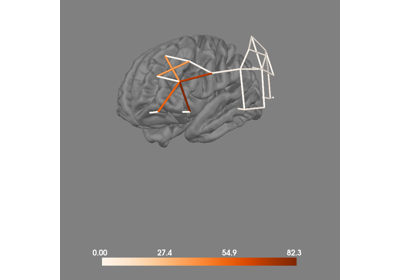mne_nirs.visualisation.plot_nirs_source_detector#
- mne_nirs.visualisation.plot_nirs_source_detector(data, info=None, radius=0.001, trans=None, subject=None, subjects_dir=None, surfaces='head', coord_frame='head', meg=None, eeg='original', fwd=None, dig=False, ecog=True, src=None, mri_fiducials=False, bem=None, seeg=True, fnirs=False, show_axes=False, fig=None, cmap=None, interaction='trackball', verbose=None)[source]#
3D visualisation of fNIRS response magnitude.
This function plots the response amplitude for each channel. Each channel is represented by a line between the source and detector, the color of the line reflects the response magnitude.
- Parameters:
- data
array Array of values to be plotted between source and detectors. One value should be specified per channel in the same order as info.chs.
- info
dict|None The measurement info. If None (default), no sensor information will be shown.
- radius
numbers Tube radius for connecting links.
- transpath-like |
dict| instance ofTransform|"fsaverage"|None If str, the path to the head<->MRI transform
*-trans.fiffile produced during coregistration. Can also be'fsaverage'to use the built-in fsaverage transformation. If trans is None, an identity matrix is assumed.- subject
str|None The subject name corresponding to FreeSurfer environment variable SUBJECT. Can be omitted if
srcis provided.- subjects_dirpath-like |
None The path to the directory containing the FreeSurfer subjects reconstructions. If
None, defaults to theSUBJECTS_DIRenvironment variable.- surfaces
str|list Surfaces to plot. Supported values:
scalp: one of ‘head’, ‘outer_skin’ (alias for ‘head’), ‘head-dense’, or ‘seghead’ (alias for ‘head-dense’)
skull: ‘outer_skull’, ‘inner_skull’, ‘brain’ (alias for ‘inner_skull’)
brain: one of ‘pial’, ‘white’, ‘inflated’, or ‘brain’ (alias for ‘pial’).
Defaults to ‘head’.
Note
For single layer BEMs it is recommended to use ‘brain’.
- coord_frame
str Coordinate frame to use, ‘head’, ‘meg’, or ‘mri’.
- meg
str|list| bool |None Can be “helmet”, “sensors” or “ref” to show the MEG helmet, sensors or reference sensors respectively, or a combination like
('helmet', 'sensors')(same as None, default). True translates to('helmet', 'sensors', 'ref').- eegbool |
str|list String options are:
- “original” (default; equivalent to
True) Shows EEG sensors using their digitized locations (after transformation to the chosen
coord_frame)
- “original” (default; equivalent to
- “projected”
The EEG locations projected onto the scalp, as is done in forward modeling
Can also be a list of these options, or an empty list (
[], equivalent ofFalse).- fwdinstance of
Forward The forward solution. If present, the orientations of the dipoles present in the forward solution are displayed.
- digbool | ‘fiducials’
If True, plot the digitization points; ‘fiducials’ to plot fiducial points only.
- ecogbool
If True (default), show ECoG sensors.
- srcinstance of
SourceSpaces|None If not None, also plot the source space points.
- mri_fiducialsbool |
str Plot MRI fiducials (default False). If
True, look for a file with the canonical name (bem/{subject}-fiducials.fif). Ifstrit should provide the full path to the fiducials file.- bem
listofdict| instance ofConductorModel|None Can be either the BEM surfaces (list of dict), a BEM solution or a sphere model. If None, we first try loading ‘$SUBJECTS_DIR/$SUBJECT/bem/$SUBJECT-$SOURCE.fif’, and then look for ‘$SUBJECT*$SOURCE.fif’ in the same directory. For ‘outer_skin’, the subjects bem and bem/flash folders are searched. Defaults to None.
- seegbool
If True (default), show sEEG electrodes.
- fnirsbool
If True (default), show fNIRS electrodes.
- show_axesbool
If True (default False), coordinate frame axis indicators will be shown:
head in pink.
MRI in gray (if
trans is not None).MEG in blue (if MEG sensors are present).
Added in version 0.16.
- figmayavi.mlab.Figure |
None Mayavi Scene in which to plot the alignment. If
None, creates a new 600x600 pixel figure with black background.Added in version 0.16.
- cmap
str Colormap to be used.
- interaction
str Can be “trackball” (default) or “terrain”, i.e. a turntable-style camera.
Added in version 0.16.
- verbosebool |
str|int|None Control verbosity of the logging output. If
None, use the default verbosity level. See the logging documentation andmne.verbose()for details. Should only be passed as a keyword argument.
- data
- Returns:
- figFigure
The 3D figure.
Notes
For more information see
mne.viz.plot_alignment().Added in version 0.15.
